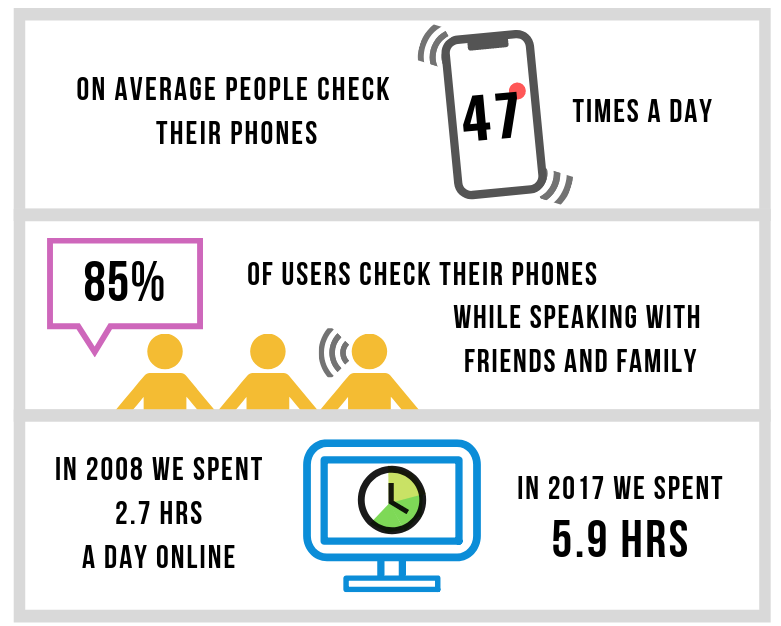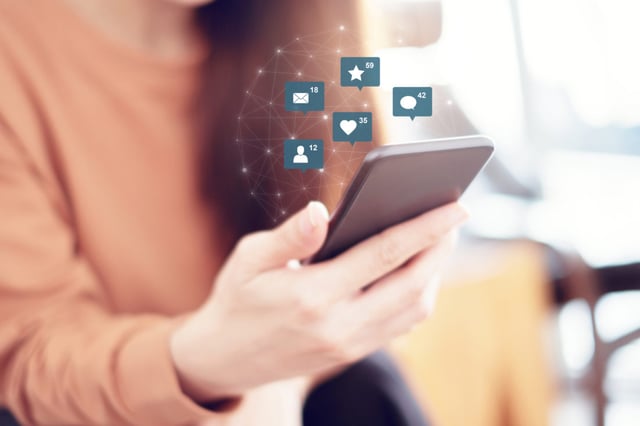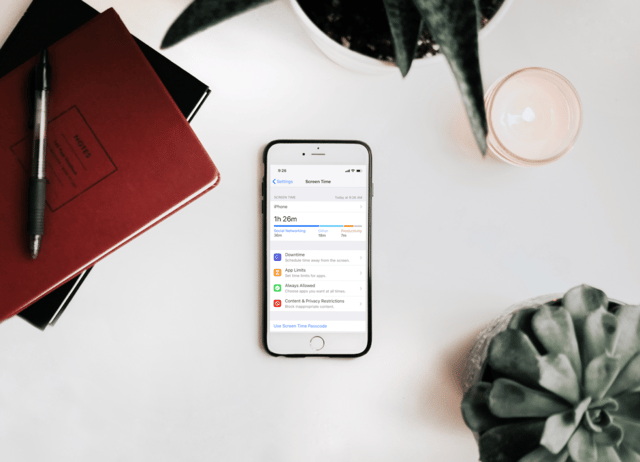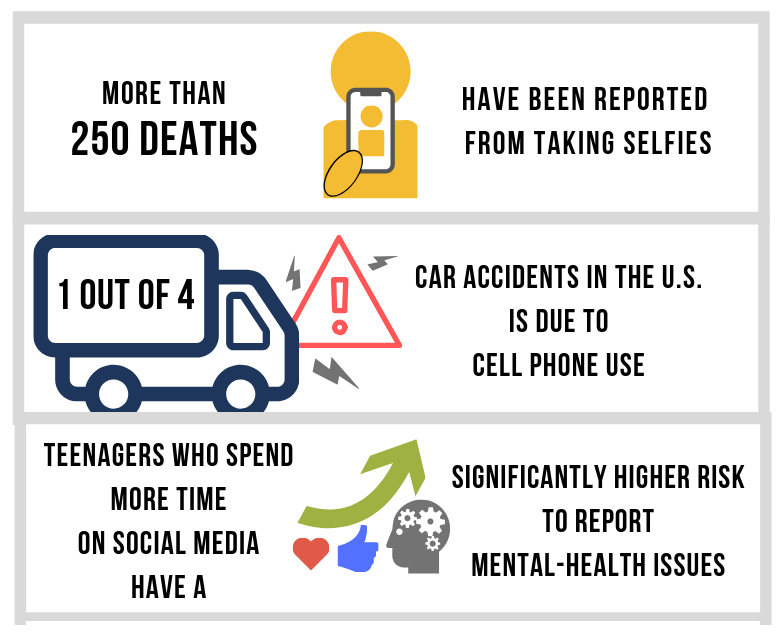How Addicted Are You? The Scary Truth About Technology Addiction
Written by Marc Alringer
You may have heard of the 12 step program for getting over a drug addiction but have you ever heard of a 12 step program for getting over a technology addiction? Clinics for technology addiction treatment are popping up all around the United States in order to cure people from their excessive use of technology. This may seem like a laughable subject as the rapid advancements in technology allow us to do amazing things. However, without taking the proper precautionary steps, people are becoming so in love with technology that it’s become a problem. Mobile devices, the Internet, and online games are consuming our attention, reducing our ability to focus, and hindering us from connecting with the people around us.
![]()
Is Technology Addiction Real?
Experts offer conflicting theories on whether technology addiction can be classified on the same level as an alcohol or drug addiction. American Psychiatric Association’s Diagnostic and Statistical Manual of Mental Health Disorders does not recognize it as an actual disorder and claims it as a “condition of further study.” However, many medical and technology professionals insist that there is a huge problem at hand. Even if it cannot be clinically recognized, the amount of time we spend staring into device screens is increasing drastically.

The most substantial change is how much time we spend on our mobile phones. In 2008, when smartphones were introduced, we spent 0.30 hours or about 24 minutes per day on our phones. Fast forward to 2018 and we are spending an average of 3.3 hours on our phones.
Why We’re Hooked
The main goal of these platforms is to retain users and maintain high engagement levels. They were designed to be engaging, addictive, and habit-forming products. It is no wonder why so much of our time is invested in them.
Social media companies’ monetization strategies are based on how many people are visiting and engaging with their content. To keep users coming back for more, these companies incorporate features that are persuasive, helpful, engaging, and much more.
Snapchat uses techniques like scarcity and the fear of missing out to encourage users to get online quickly before content disappears. Features such as “likes” and “re-shares” give social credibility to users as well as boost their self-esteem. Messenger apps put pressure on users to respond quickly as other users can see when their sent messages have been read. Notifications and alerts are made prominent on user interfaces to grab your attention and spike your curiosity.
![]()
Online games have similar features that keep users hooked for hours and in extreme cases even days. Games with no definitive end or stop signals encourages users to play for hours. A game with no definitive end is hard to put down. The only way to stop is if the player voluntarily opts-out, but they are too ingrained in the game to be self-aware.
Another main contributor to hours of online gaming is the reward systems. Gamers are incentivized and receive rewards for logging-in consecutively or completing tasks/challenges. For example, a player may receive a badge for leveling up. This positive reinforcement encourages gamers to play for hours on end. Lastly, online games are constantly updated whether the user is online or not. Missing out on new updates and exciting new features may decrease a player’s likelihood of completing a certain challenge or mission. This ultimately forces users to consistently login to keep up to date with the game’s evolving strategy.
But can we really blame these companies for creating really engaging products? Or have we just lost our self-control? We know the games and apps get us hooked and keep us online for hours, yet we still willingly go on not caring if part of our day is completely “wasted”.
What The Online Tech Experts Are Saying
The developers of these addictive features are turning their backs on their own inventions. The features they once thought were revolutionary have been abused beyond their original intention. Many of these technologists are not even using their own products or even letting their kids use it. These elite Silicon Valley techs are sending their children to schools where technology is banned.
Aza Raskin, who invented the infinite scroll feature for the web, regrets bringing it to users’ interfaces. He explains that when content continuously loads, without any stopping cues, as you scroll, “your brain does not have a chance to catch up with your impulses”, thus leading to numerous hours wasted on nothing.

Several other former Facebook executives who set up the like-based system have begun to speak out about the negative impact that these features have created. Sean Parker, the founding President of Facebook, and Chamath Palihapitiya who was Facebook’s VP of user growth have similar views about the unintentional consequences that arose from Facebook inventing the “like”:
“The short-term dopamine-driven feedback loops that we have created are destroying how society works. We curate our lives around this perceived sense of perfection because we get rewarded in these short-term signals; hearts, likes, thumbs up. And we conflate that with value, and we conflate it with truth. And instead what it really is, is fake, brittle popularity. That’s short-term and that leaves you even more, vacant and empty before you did it. Think about this vicious cycle compounded by two billion people, and then think about how people react then to the perceptions of others. It’s just a really bad thing, it’s really, really bad…”
Attempting To Reduce Mobile Phone Usage
With all these manipulative features to keep us engaged, smartphone companies are enforcing ways to help us regulate the time spent on their products. For example, Google released a full list of features that help users manage and limit their screen time on their mobile devices. “Time spent” dashboard will give users information on stats like how many times they have unlocked their phone, the total time spent on the device, and the number of notifications received. Apple has a similar dashboard called “Screen time” that will show you phone usage as well as give you the ability to set usage limits on certain apps.

“Wind down” on Google will turn the phone display to grayscale when it is time for bed. Google also has a “Shush” feature which will put the device on silent mode when the device is turned over face down on a flat surface. Apple has updated their “Do Not Disturb” mode with “Do Not Disturb Bedtime” allowing you to not only mute the notification but also delay them from showing up on the screen until later in the morning when you are ready for them.
We have seen features to restrict excessive screen time before on platforms like Netflix, giving us the “Are you still watching?” alert. Youtube is also rolling out features to help users reduce binge-watching habits. Although the intention of these features is to draw awareness to the excessive time users are spending on these platforms, they are receiving backlash in regards to how impactful they truly are.
Time usage alerts can be ignored by simply clicking the “dismiss” button that appears on the same screen as the alert. If users want to set restrictions they must take the time to set these up for each individual app and can easily undo them in their settings. While these features may not have a huge impact on technology use, I have to give these companies credit for creating awareness and giving users the ability to better understand the time they spend on their devices.
Is technology addiction really a problem?
Well…

So yes, there is undeniably something wrong with our relationship to technology. From the large number of statistical reports, short-term studies, and voiced concerns from healthcare and technology professionals you cannot ignore that we have developed an unhealthy connection to technology. But don’t these let negative impacts take away all the extraordinary advancements technology has enabled.
We can hold the answer to all the questions we could ever ask on a device that fits in our hands. We have the ability to learn about any topic we wish with just a couple of clicks. We can connect to people on the other side of the world within minutes. We can even view pictures of our world in seconds. Technology has brought incredible improvements to education, the healthcare industry, and much more. The world has never before been as connected as it is now, and that is due to technology.
“We need to re-calibrate our relationship with our technology.”
According to Arianna Huffington, “This is one of the most important conversations of our time. And ironically, this conversation is the very thing our addiction to our screens prevents. We’re so busy scheduling our lives, documenting them, logging them, tracking them, memorializing and sharing them that we’re not actually living them. Importantly, our ability to have this conversation won’t last forever. The rise of AI and the increasing hyper-connectivity of our daily lives has the potential to erode our humanity even further.” To re-establish our relationship we have to exercise some self-control and prove that we are the ones in control of the technology we hold, not the other way around.






